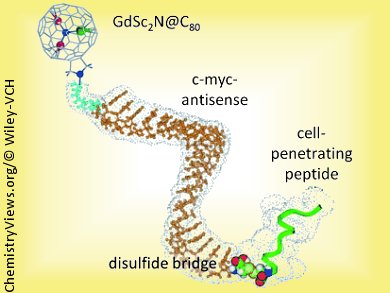Lothar Dunsch, Leibniz Institute of Electrochemistry and Conducting Polymers, Germany, Klaus Braun, German Cancer Research Center, Heidelberg, and co-workers tackle the pitfalls of the administration of magnetic resonance imaging (MRI) contrast agents through the modular design of a BioShuttle.
The first module in the BioShuttle is the actual lanthanide, which is used as a contrast agent in MRI or as a therapeutic radiopharmaceutical. Whereas free lanthanides are known to be toxic, encapsulated lanthanides as mixed-metal nitride cluster fullerenes, GdxSc3–xN@C2n (x=0–3, 39⩽n⩽44), show reduced toxicity and superior water proton relaxivities.
The second module consists of a peptide nucleic acid (PNA) antisense sequence specifically targeting c-myc mRNA, which is expressed in cancer cells. This “address” module provides the BioShuttle with specificity for cancer cells.
Lastly, the third module consists of a cell-penetrating peptide, which is attached through a cleavable disulfide bridge and facilitates cell delivery. All modules act together to give a platform for specific delivery of lanthanide–scandium mixed-metal cluster fullerenes into target cells.
- A Platform for Specific Delivery of Lanthanide–Scandium Mixed-Metal Cluster Fullerenes into Target Cells,

Anna Svitova, Klaus Braun, Alexey A. Popov, Lothar Dunsch,
ChemistryOpen 2012, 1(5), 207–210.
DOI: 10.1002/open.201200023
ChemistryOpen – the first society-owned, open-access, chemistry journal – is a journal of ChemPubSoc Europe published by Wiley-VCH.




